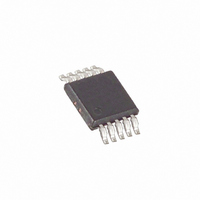MAX6641AUB96+T Maxim Integrated Products, MAX6641AUB96+T Datasheet - Page 15

MAX6641AUB96+T
Manufacturer Part Number
MAX6641AUB96+T
Description
IC TEMP MONITOR SMBUS 10UMAX
Manufacturer
Maxim Integrated Products
Datasheet
1.MAX6641AUB96.pdf
(17 pages)
Specifications of MAX6641AUB96+T
Function
Fan Control, Temp Monitor
Topology
ADC, PWM Generator, Tach Counter
Sensor Type
External & Internal
Sensing Temperature
-40°C ~ 125°C, External Sensor
Output Type
I²C™/SMBus™
Output Alarm
Yes
Output Fan
Yes
Voltage - Supply
3 V ~ 5.5 V
Operating Temperature
-40°C ~ 125°C
Mounting Type
Surface Mount
Package / Case
10-MSOP, Micro10™, 10-uMAX, 10-uSOP
Full Temp Accuracy
+/- 4 C
Digital Output - Bus Interface
Serial (2-Wire)
Digital Output - Number Of Bits
8 bit
Maximum Operating Temperature
+ 125 C
Minimum Operating Temperature
- 40 C
Lead Free Status / RoHS Status
Lead free / RoHS Compliant
The effects of the ideality factor and series resistance
are additive. If the diode has an ideality factor of 1.002
and series resistance of 3 , the total offset can be cal-
culated by adding error due to series resistance with
error due to ideality factor:
for a diode temperature of +85°C.
In this example, the effect of the series resistance and
the ideality factor partially cancel each other.
For best accuracy, the discrete transistor should be a
small-signal device with its collector connected to GND
and base connected to DXN. Table 6 lists examples of
discrete transistors that are appropriate for use with
the MAX6641.
The transistor must be a small-signal type with a rela-
tively high forward voltage; otherwise, the A/D input
voltage range can be violated. The forward voltage at
the highest expected temperature must be greater than
0.25V at 10µA, and at the lowest expected tempera-
ture, the forward voltage must be less than 0.95V at
100µA. Large power transistors must not be used. Also,
ensure that the base resistance is less than 100 . Tight
specifications for forward-current gain (50 < ß <150, for
example) indicate that the manufacturer has good
process controls and that the devices have consistent
VBE characteristics.
The integrating ADC used has good noise rejection for
low-frequency signals such as 60Hz/120Hz power-sup-
ply hum. In noisy environments, high-frequency noise
reduction is needed for high-accuracy remote measure-
ments. The noise can be reduced with careful PC board
layout and proper external noise filtering.
High-frequency EMI is best filtered at DXP and DXN with
an external 2200pF capacitor. Larger capacitor values
can be used for added filtering, but do not exceed
3300pF because larger values can introduce errors due
to the rise time of the switched current source.
Follow these guidelines to reduce the measurement
error of the temperature sensors:
1) Place the MAX6641 as close as is practical to the
remote diode. In noisy environments, such as a
computer motherboard, this distance can be 4in to
8in typically. This length can be increased if the
worst noise sources are avoided. Noise sources
include CRTs, clock generators, memory buses,
and ISA/PCI buses.
SMBus-Compatible Temperature Monitor with
1.36°C - 2.13°C = -0.1477°C
______________________________________________________________________________________
Automatic PWM Fan-Speed Controller
ADC Noise Filtering
PC Board Layout
2) Do not route the DXP-DXN lines next to the deflec-
3) Route the DXP and DXN traces in parallel and in
4) Route through as few vias and crossunders as pos-
5) When introducing a thermocouple, make sure that
6) Use wide traces. Narrow traces are more inductive
7) Add a 200
8) Copper cannot be used as an EMI shield; only fer-
Table 6. Remote-Sensor Transistor
Manufacturers
Central Semiconductor (USA)
Rohm Semiconductor (USA)
Samsung (Korea)
Siemens (Germany)
tion coils of a CRT. Also, do not route the traces
across fast digital signals, which can easily intro-
duce 30°C error, even with good filtering.
close proximity to each other, away from any higher
voltage traces, such as 12VDC. Leakage currents
from PC board contamination must be dealt with
carefully since a 20M
ground causes about 1°C error. If high-voltage traces
are unavoidable, connect guard traces to GND on
either side of the DXP-DXN traces (Figure 9).
sible to minimize copper/solder thermocouple
effects.
both the DXP and the DXN paths have matching
thermocouples. A copper-solder thermocouple
exhibits 3µV/°C, and takes about 200µV of voltage
error at DXP-DXN to cause a 1°C measurement
error. Adding a few thermocouples causes a negli-
gible error.
and tend to pick up radiated noise. The 10-mil
widths and spacing recommended in Figure 9 are
not absolutely necessary, as they offer only a minor
improvement in leakage and noise over narrow
traces. Use wider traces when practical.
noise filtering (see the Typical Application Circuit).
rous materials such as steel work well. Placing a
copper ground plane between the DXP-DXN traces
and traces carrying high-frequency noise signals
does not help reduce EMI.
MANUFACTURER
resistor in series with V
leakage path from DXP to
MODEL NO.
KST3906-TF
CMPT3906
SMBT3906
SST3906
CC
for best
15









